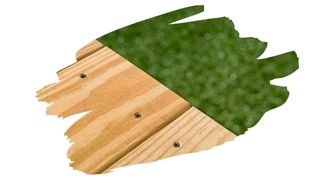Wood is a natural material that — depending on the specific species — can last for ages with the right care. And, when it comes to exterior wood, the right care often involves extra chemical treatments to help wood stave off rot and decay.
Now, there are a few different milling treatments that can make natural wood more rot-resistant. And it is not always obvious as to which ones involve chemicals, and which ones do not.
For example, take kiln drying (a method that involves heat treating wood), and pressure treatment. These two milling treatments help preserve wood in two very different ways.
But, how do they do it? And which one is better for wood?
Well, in this post, you will find out the key differences between kiln-dried timber and pressure treated lumber. You’ll also discover why kiln drying can speed up wood seasoning – reducing a yearlong process down to mere days.
And keep reading to learn how to quickly identify wood that has been both kiln dried and pressure treated — and why these boards are better for exterior structures.

This post may contain affiliate links to products that we receive a commission for (at no additional cost to you). Learn more here.
OK, So Tell Me What Kiln Dried Wood Is All About?
Well, kiln-dried wood is freshly cut lumber that’s been seasoned in a kiln-oven (rather than air dried).
Traditional air-dried seasoned wood can take six to twelve months to dry out. But, wood that’s been kiln-dried takes just a few days to season. This is because the wood is baked at 94°C (201.2°F) for up to 36 hours.
What’s more, kiln drying leaves wood with an even lower moisture content than air dried wood. Moisture content refers to the amount of moisture found in a single log or wooden board.
Air-dried seasoned wood can take up to a year to reduce to a moisture content level of 19%. But, kiln dried wood only needs days to get down to a moisture content level as low as 12%.
But Is Kiln Dried Wood Toxic?
Untreated kiln dried wood has simply been ‘seasoned’ in a kiln oven. There are no toxic preservatives or fumigating chemicals added to any wood that has merely been kiln dried.
You see, the aim of kiln-drying is to help increase the stability of wood. If there is very little moisture in wood, then wood is less likely to shrink and crack due to that moisture evaporating.
But, the process of simply kiln drying wood does not involve any chemicals or fumigation. It’s just a heat-treatment.
Related Post: Is Kiln Dried Wood Safe To Burn In An Indoor Fireplace?
So Is Kiln Dried Wood Good For Fences?
Well, kiln-dried wood is fine in all circumstances. However, when it comes to exterior timber, you will often find that kiln dried wood will have been further treated.
This additional treatment, (that exterior timber goes through), is called pressure treatment. And pressure treatment involves saturating wood with chemical preservatives.
Those preservatives help wood fight off mold bacteria and stave off decay. Which is why it’s commonplace to treat outdoor timber with these chemicals.
Related Post: Is Kiln Dried Wood Safe Enough To Use For Gardens And Landscaping?
Wait A Minute…Isn’t Kiln Dried Wood The Same Thing As Pressure Treated Wood?
Far from it. You see, Kiln drying and pressure treating are two separate milling processes.
But you can be forgiven for being confused about the difference between the two. Why? Well, because most kiln dried wood meant for outdoor structures tend to also be pressure treated.
These particular kiln-dried wooden boards are stamped with KDAT, which means ‘K.iln D.ried A.fter T.reating’. These KDAT boards have been soaked in water-soluble chemical wood preservatives, and then dried out in a kiln oven.
But Why Bother With Pressure Treatment If Wood Is Already Kiln Dried?
Well, because kiln drying only serves to make wood more stable. However, pressure treatment is key to making wood rot resistant.
And when you combine these treatments, you make wood more durable and less likely to warp or decay.
To Wrap Up, Here Are The 3 Key Takeaways From This Post…
- 1). Kiln dried wood has been seasoned using a heat-treatment involving a kiln-oven. This allows kiln-dried wood to season in a fraction of the time of traditionally air-dried timber.
- 2). Pressure treated wood has been saturated with rot-resistant chemical wood preservatives. This helps wood to stave off mold bacteria and decay.
- 3). Kiln drying and pressure treatment are two separate milling processes. However, when they are combined together, they help to make wood more stable and long-lasting.



